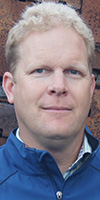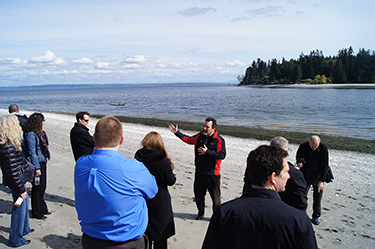|
Subscribe / Renew |
|
|
Contact Us |
|
| ► Subscribe to our Free Weekly Newsletter | |
| home | Welcome, sign in or click here to subscribe. | login |
Architecture & Engineering
| |
 |
November 20, 2014
The task: make a new waterfront, but keep it real
Berger Partnership

Michaelsen
|
Even in its existing state, for all its urban design and civic shortcomings, our waterfront has a wonderful soul and sense of place unique to Seattle.
As we reimagine our waterfront with wonderful, vibrant civic spaces and newly created urban ecologies, for me the greatest excitement is the opportunity to honor its existing character while further infusing it with the essence of Seattle.
Many separate yet integrated projects make up the waterfront project and they embody ambitious and amazing engineering, infrastructure and design. By necessity, these projects will rebuild every square foot of landscape from the east face of the piers to the west face of the buildings fronting Alaskan Way. Yet, when completed, our waterfront will be filled with elements inspired by, and that reinforce, a character unique to Seattle.
With the vision largely shaped, the next steps of design will focus on how we realize this vision at a human scale and continue to infuse our city’s soul into this new place.
As I speak of my passion for place, here are my credentials: lifelong Seattle resident, born and raised; well-traveled, and lived overseas for six years. While I am always inspired by lessons from other cities, I ultimately believe Seattle is unique and second to none.
My earliest memories of the waterfront are Pier 70, which was then a collection of quirky shops, and getting ice cream at the Wet Whisker (one of Seattle’s first coffee roasters!). I have watched the waterfront change, including the loss of many unique elements one by one—the numerous trestles crossing the road burnt or removed, the web of intersecting railroad tracks torn out, pier sheds and warehouses demolished.
Our reimagined waterfront reintroduces some of that long-erased originality and memory. It is a catalyst to shape new layers of character, designed to welcome a “Seattle patina” as we grab hold of our new waterfront, reclaim it, love it, and make it our own long after the project is complete.
Places and elements inspired by the past: The design includes a variety of spaces from “social intersections” filled with activity to “tideline terraces” that provide moments of calm and escape. Within these spaces are contemporary design elements inspired by our central waterfront’s past, such as seating bleachers constructed of assemblies of new and salvaged large-scale timbers that speak to both ships and historic pier sheds.
Meandering through the tideline terraces, boardwalks are perched over planting areas, recalling the wooden trestles that once defined our waterfront. The 1920s balustrade that has long marked the abrupt edge from city to bay will be salvaged and repositioned as a gateway to the new promenade. What was once a barrier will become a furnishing in new gathering spaces.
The green art deco sign bridges that have long marked vehicular gateways to downtown on Highway 99 are reimagined as new pedestrian portals to our waterfront, repopulated with new cultural content or art.
Ecologically, after over a century of impacting the bay with development, the city will be giving back to the bay with marine habitat improvements of the seawall. This will be coupled with the creation of new upland habitat of native plants for people to enjoy even as they enhance ecological function.
Together, all these elements and more will root our waterfront in its past even as it acknowledges its evolution.
A tribal influence
Honoring the past and celebrating living cultures: One of the great opportunities of this project, and most personally rewarding, has been collaborating with local tribes and urban Indians to shape our new waterfront.
The design team has traveled to visit, listen to, and learn from numerous tribes and cultural spaces. Our visits have inspired us, and we have returned from each one with new lessons learned and emerging themes shaping our project.
The integration of a meaningful and accurate tribal presence is an exciting element of the new waterfront, but far more than history, the new waterfront will celebrate the living cultures of our growing tribes and Native populations.
Our continued excitement around this tribal presence and the waterfront is building. We will continue to work with the tribes to shape tribal presence on our waterfront, both as a layer across the whole waterfront and also as specific elements and places on the waterfront.
Storytelling
Inspired by nearly three years of outreach to the community, and strengthened through our work with the tribes, we have realized everyone has stories and memories of our waterfront and we are struck by the power of these stories.
The waterfront design intends to welcome and share these stories orally, in writing and in art. Integrated into the design is a wayfinding system that will help people navigate to and through the waterfront, but will also become a catalyst for sharing stories of history, science, ecology, and culture.
These stories will be omnipresent along the waterfront and integrated into design elements and furnishings, as well as existing digitally, a concept we call “1000+.”
This curated collection can evolve and change as part of the design, with some stories having a physical presence on the waterfront, but a much greater library living digitally. We think of it as our waterfront’s version of StoryCorps, an oral-history project that airs on public radio.
The stories will help document our history and today’s culture, welcoming the ordinary and extraordinary, the required and the inspired, the silly and the serious … the assemblage of which will represent the soul of our city!
The character infused into our new waterfront assures it will be a civic space that embodies the whole city, our diverse community, our history and even our aspirations. While the project itself lies at the foot of downtown Seattle, this will become all of Seattle’s waterfront.
It is being designed first and foremost as a place for Seattleites, but like the Pike Place Market and other local treasures, it will be a destination for all who visit Seattle to experience our city at its best and most authentic. Beyond physical transformation, the central waterfront project, if embraced and realized with passion and energy, can change our city’s collective civic attitude and psyche.
Guy Michaelsen is a principal at Berger Partnership and serves as the local landscape architect for the Seattle Downtown Waterfront project.
Other Stories:
- Mack Urban's tower first out of the blocks
- Some of the biggest changes — that you won't see
- We still have a lot to learn from Pike Place Market
- Art takes center stage on new waterfront
- Putting a whole new light on the waterfront
- Thousands of public comments help shape the design



